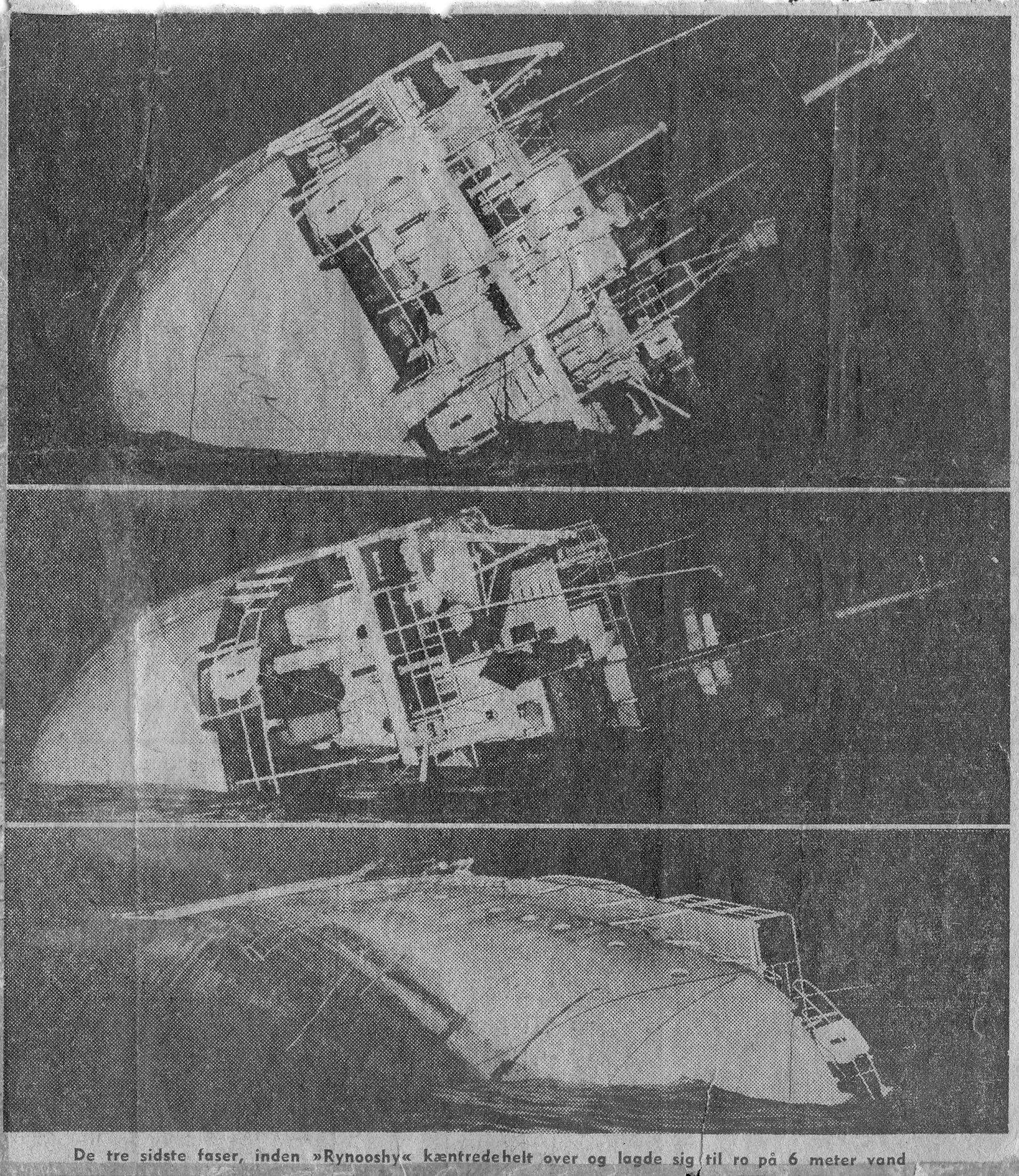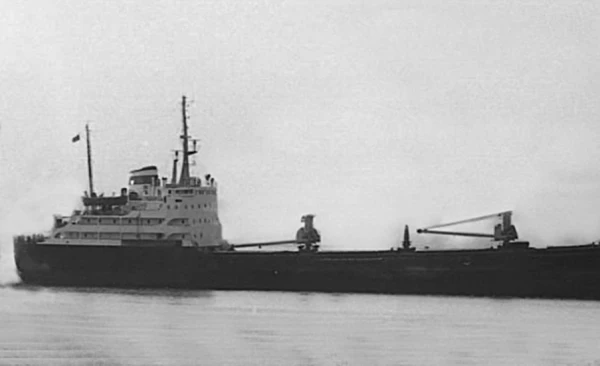
From the records in the ship's log of the second watch officer Oleg Shovgeni, it is known that the collision of the Finnish steamer “Rundal” and our passenger ship “Rinuzhi” occurred at the coordinates: latitude — 55 degrees 26.2 minutes North. Longitude — 12 degrees 43.4 minutes East.
The beginning HERE
Three blows were dealt to our ship by the Finnish vessel. The first — to the cheek of the port side, seemingly the strongest. The second — in the area of the bulkhead between the third and second holds, and the third — to the superstructure.
Immediately, a list to port appeared. It quickly increased. Within just a few minutes after the collision, the list approached thirty degrees.
The breach — between the holds
For us, on the boat deck, the speed at which the list increased seemed incredible. So we could only wait for the ship to “make an overkill.” It turned out to be impossible to lower the lifeboats on both sides. The lifeboat on the starboard side — due to the significant list to port, and the lifeboat on the port side was smashed by the steamer “Rundal” as it slid along the superstructure.
The Finnish steamer, fearing that the “Rinuzhi” would quickly sink and drag it down into the vortex, moved to a safe distance.
The second blow was fatal for our vessel when it listed from the first blow and the Finnish steamer made a breach in the area of the midship frame, in the area of the bulkhead between the second and third holds. Water gushed in immediately — into both holds (there were only three on the ship).
Captain of the “Rinuzhi” Fyodor Filimonovich Oleinikov correctly identified the location of the breach and ordered a patch to be installed. The sailors brought the bow and stern under-keel ends, secured them to the corners of the patch, and stretched it, trying to cover the breach. But it was not possible to press it tightly against the “wound.”
Unfortunately, it was impossible to get inside the holds, as they were loaded to the brim with coke, which our ship was supposed to deliver from Liepaja to the Danish port of Thisted.
We had to move around the ship like acrobats: the starboard side sank into the water, while the port side was mangled by the “Rundal,” pressing the outer corridor into the superstructure. Bosun Anatoly Gavrikov took me as a partner to close the portholes. The butterfly nuts were already closed. But we also needed to close the bronze covers, which is what the special cover that protects the porthole is called in maritime slang.
Lashing with the Finnish steamer
We moved from room to room. In one of them, just before the collision, the sailors were painting the bulkheads. Due to the list, a bucket of paint tipped over, and Dutch enamel spilled across the deck.
— Oh, the paint! — exclaimed the bosun.
And so much despair, irreparable misfortune was in the voice of the master of the deck, I would not be mistaken to say. After all, he treated the beloved vessel with love and even tenderness. Just as the sailors finished scraping the rust, applying red lead to the deck, and painting it, the bosun launched this process into life again. So the deck of the “Rinuzhi” on the day of the collision shone with enamel green, contrasting with the heaved rust on the deck of the steamer that made a breach in the side of our lovingly maintained vessel.
The list decreased after we filled the ballast tanks on the starboard side. The “Rundal,” seeing that the “Rinuzhi” was not going to sink just yet, approached its side, and we threw mooring lines to the steamer, mooring it alongside. Gradually, the list leveled out. Now we were able to calmly lower the lifeboat on the starboard side and transfer the half-packed suitcases onto the Finnish vessel.
Soon, over the loudspeaker, the command sounded: “Crew to abandon ship! Move to the steamer ‘Rundal’!” — and our entire crew, except for the captain, the watch officer on the bridge, and the chief engineer in the engine room, moved over to the “Rundal,” which was towing the sinking steamer to the shallows. However, there were some moments that I would like to draw attention to. For example, one of the ship's officers, who sang quite well, climbed up to the upper open deck of the superstructure above the wheelhouse — and a song soared over the Baltic Sea:
– Our proud “Varyag” does not surrender to the enemy,
– No one desires mercy…
When the second mate checked if everyone had moved to the steamer, it turned out that our only woman, the stewardess (now this position is called a flight attendant), was missing. The sailors had followed the order. Everyone except the stewardess. Let’s call her Alena.

The stern of the sinking steamer “Rinuzhi.” Photo from the tug.
Looking for the woman!
Bosun Anatoly Gavrikov says to me:
— Vovka, let’s go look for the missing one! Maybe she got caught by a door, or Alena tripped over something and hurt her leg. Let’s search!
And so, the bosun and I are back on the empty sinking steamer. We run around almost all the rooms. No Alena — and that’s it!
Towards the end of the search, we find ourselves at the mess room. Strange sounds are coming from there. It seems someone is clattering dishes. The bosun flings open the door — and we see the stewardess. She is crawling on her knees across the deck, collecting in a cardboard box what remains of broken cups, glasses, and plates. She has already collected a lot of shards.
After the collision, during the unexpected list of the ship, the dishes set on the table for evening tea fell onto the mess room deck and broke. And now Alena is searching for its shards, rummaging in the farthest corners.
— What collection are you gathering?! — shouts the bosun.
— What do you mean! No one will write off this broken dish without presenting material evidence, without shards! I am a materially responsible person!
In those days, it was indeed not enough to have an act for writing off even broken dishes during a strong roll; a record from the ship's log about stormy weather was also required. Periodically, every few months, an inspector from the shipping company would arrive at the Soviet port. After checking the presence of shards, he would allow the broken dishes to be written off. Only two years after the events described did the requirement to present the remains of cups and plates get canceled.
The bosun was not swayed by Alena’s arguments.
— Do you understand that the ship is sinking?! Let’s get out of here! — he shouted.
The ship is relentlessly sinking
The “Rundal” was towing the “Rinuzhi” to the shallows. On the bow and stern of the steamer, Finnish sailors were standing at the bitts with our mooring lines, ready to throw off the lines and move away from the sinking poor thing if necessary. After all, our vessel was constantly sinking, which the watch officer periodically reported to the captain.
But then the “Rundal,” fearing that it would also run aground, decided to “release” the “Rinuzhi.” By that time, our entire crew, seeing the absence of a list, preparing to “sit on the shallows” while waiting for the Soviet rescuer, had already moved back to their ship.
They released the stern lines — and immediately our stern was pulled away from the Finnish steamer, while a list appeared on the opposite side, to the starboard.
From the bridge of the “Rinuzhi,” they ordered the stern to moor again, but it was already far away, and the sailors on duty at the bitts of the Finnish steamer were ordered to release all our lines. They did not hesitate — and the “Rundal” moved away to a safe distance again.
The list of the “Rinuzhi” increased slowly this time, but the ship was relentlessly sinking.
Vladimir NOVIKOV
Continuation HERE













Leave a comment